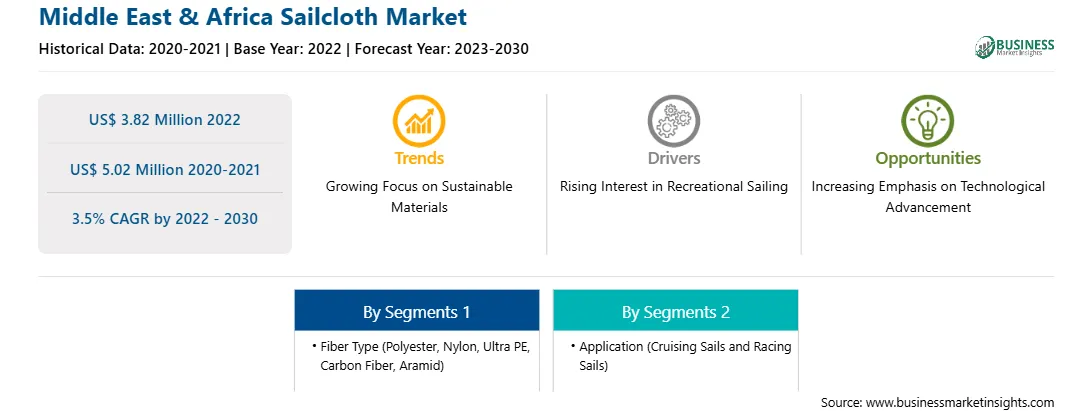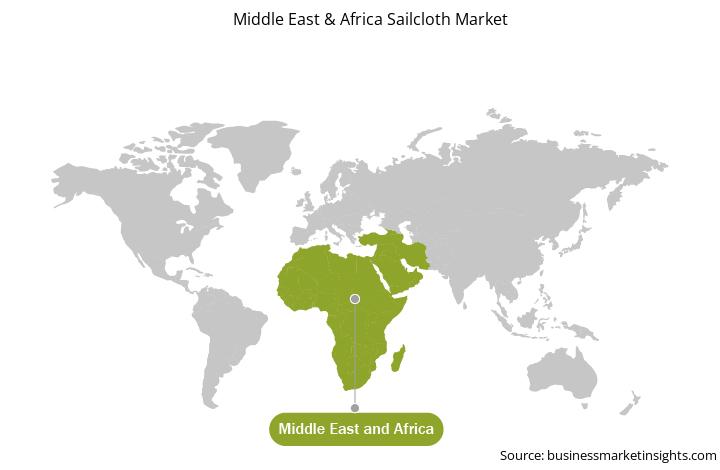The Middle East & Africa sailcloth market was valued at US$ 3.82 million in 2022 and is expected to reach US$ 5.02 million by 2030; it is estimated to register a CAGR of 3.5% from 2022 to 2030.
Sustainability is becoming a key focus in sailcloth innovation, with the development of eco-friendly materials and production processes. The sailcloth market is undergoing a transformative shift driven by the growing focus on sustainable materials. This has propelled the demand for sailcloth that not only deliver high performance but also align with eco-friendly principles. Sustainable sailcloth materials encompass a range of options, including recycled fibers, bio-based polymers, and fabrics derived from renewable sources. Sail manufacturers are proactively responding to this shift by incorporating these materials into their product lines, addressing resource depletion and waste generation concerns. The sailcloth industry's commitment to sustainability goes beyond regulatory compliance, reflecting an acknowledgment of its role in minimizing its ecological footprint. The development of sailcloth made from recycled plastic, bamboo fibers, and other sustainable materials will most likely cater to the growing demand for eco-conscious products. In January 2024, North Sails announced the launch of NPL Renew, a sustainable sailcloth for yachts up to 45 feet (13.7 meters) in length that consists of 90% recycled material and Finnish trees. As environmental consciousness grows within the sailing community and beyond, sailcloth manufacturers are investing in solutions that reduce their ecological footprint. This focus on sustainable materials in the sailcloth market is not merely a response to consumer trends, but it also represents a strategic move for the development of the industry in future. As governments and organizations worldwide prioritize environmental sustainability, sailcloth manufacturers that embrace eco-friendly practices position themselves as leaders in responsible production. This, in turn, opens up new avenues for growth as environmentally conscious sailors actively seek out products that align with their values. Thus, the growing focus on sustainable materials is a compelling force projected to shape the future of the sailcloth market.
The Middle East & Africa sailcloth market is undergoing notable growth, driven by a confluence of economic, social, and environmental factors. At its core lies the burgeoning yachting industry, fueled by rising disposable incomes, a growing appetite for luxury leisure activities, and government investments in developing coastal infrastructure. Countries such as the UAE, Saudi Arabia, and Morocco are witnessing a surge in yacht ownership and marinas, creating a robust need for high-performance sailcloth for racing and cruising enthusiasts. Additionally, advancements in sailcloth technology are playing a crucial role in its rising popularity. Manufacturers are innovating with high-tech materials, including Kevlar and Dyneema, offering exceptional strength-to-weight ratios and improved UV resistance, perfectly suited for the demanding Middle Eastern & African climates. Developments in sail design software and automation are leading to more efficient and customized sail production, catering to the specific needs of regional sailors. Furthermore, the region is witnessing a surge in sailing competitions, from prestigious international races such as the America's Cup World Series in Bahrain to local regattas across coastal communities. Other events, such as SailGP and SB20 World Championship, also act as catalysts for innovation to develop cutting-edge sailcloth with superior performance characteristics. In addition, sporting events act as powerful magnets for tourism, and sailing is often a highly sought-after activity for visitors. This leads to increased demand for charter yachts and recreational sailing experiences, all of which require high-performance and durable sailcloth to ensure safety for participants.
Strategic insights for the Middle East & Africa Sailcloth provides data-driven analysis of the industry landscape, including current trends, key players, and regional nuances. These insights offer actionable recommendations, enabling readers to differentiate themselves from competitors by identifying untapped segments or developing unique value propositions. Leveraging data analytics, these insights help industry players anticipate the market shifts, whether investors, manufacturers, or other stakeholders. A future-oriented perspective is essential, helping stakeholders anticipate market shifts and position themselves for long-term success in this dynamic region. Ultimately, effective strategic insights empower readers to make informed decisions that drive profitability and achieve their business objectives within the market.

| Report Attribute | Details |
|---|---|
| Market size in 2022 | US$ 3.82 Million |
| Market Size by 2030 | US$ 5.02 Million |
| Global CAGR (2022 - 2030) | 3.5% |
| Historical Data | 2020-2021 |
| Forecast period | 2023-2030 |
| Segments Covered |
By Fiber Type
|
| Regions and Countries Covered | Middle East and Africa
|
| Market leaders and key company profiles |
The geographic scope of the Middle East & Africa Sailcloth refers to the specific areas in which a business operates and competes. Understanding local distinctions, such as diverse consumer preferences (e.g., demand for specific plug types or battery backup durations), varying economic conditions, and regulatory environments, is crucial for tailoring strategies to specific markets. Businesses can expand their reach by identifying underserved areas or adapting their offerings to meet local demands. A clear market focus allows for more effective resource allocation, targeted marketing campaigns, and better positioning against local competitors, ultimately driving growth in those targeted areas.

The Middle East & Africa sailcloth market is categorized into fiber type, application, and country.
Based on fiber type, the Middle East & Africa sailcloth market is categorized into polyester, nylon, ultra PE, carbon fiber, aramid, and others. The polyester segment held the largest market share in 2022.
In terms of application, the Middle East & Africa sailcloth market is bifurcated into cruising sails and racing sails. The racing sails segment held a larger market share in 2022.
By country, the Middle East & Africa sailcloth market is segmented into Saudia Arabia, the UAE, South Africa, and the Rest of Middle East & Africa. Saudi Arabia dominated the Middle East & Africa sailcloth market share in 2022.
Ullman Sails International Inc, Evolution Sails USA, Quantum Sails Design Group LLC, Elvstrom Sails AS, North Sails GmbH, and Contender BV are some of the leading companies operating in the Middle East & Africa sailcloth market.
The Middle East & Africa Sailcloth Market is valued at US$ 3.82 Million in 2022, it is projected to reach US$ 5.02 Million by 2030.
As per our report Middle East & Africa Sailcloth Market, the market size is valued at US$ 3.82 Million in 2022, projecting it to reach US$ 5.02 Million by 2030. This translates to a CAGR of approximately 3.5% during the forecast period.
The Middle East & Africa Sailcloth Market report typically cover these key segments-
The historic period, base year, and forecast period can vary slightly depending on the specific market research report. However, for the Middle East & Africa Sailcloth Market report:
The Middle East & Africa Sailcloth Market is populated by several key players, each contributing to its growth and innovation. Some of the major players include:
The Middle East & Africa Sailcloth Market report is valuable for diverse stakeholders, including:
Essentially, anyone involved in or considering involvement in the Middle East & Africa Sailcloth Market value chain can benefit from the information contained in a comprehensive market report.